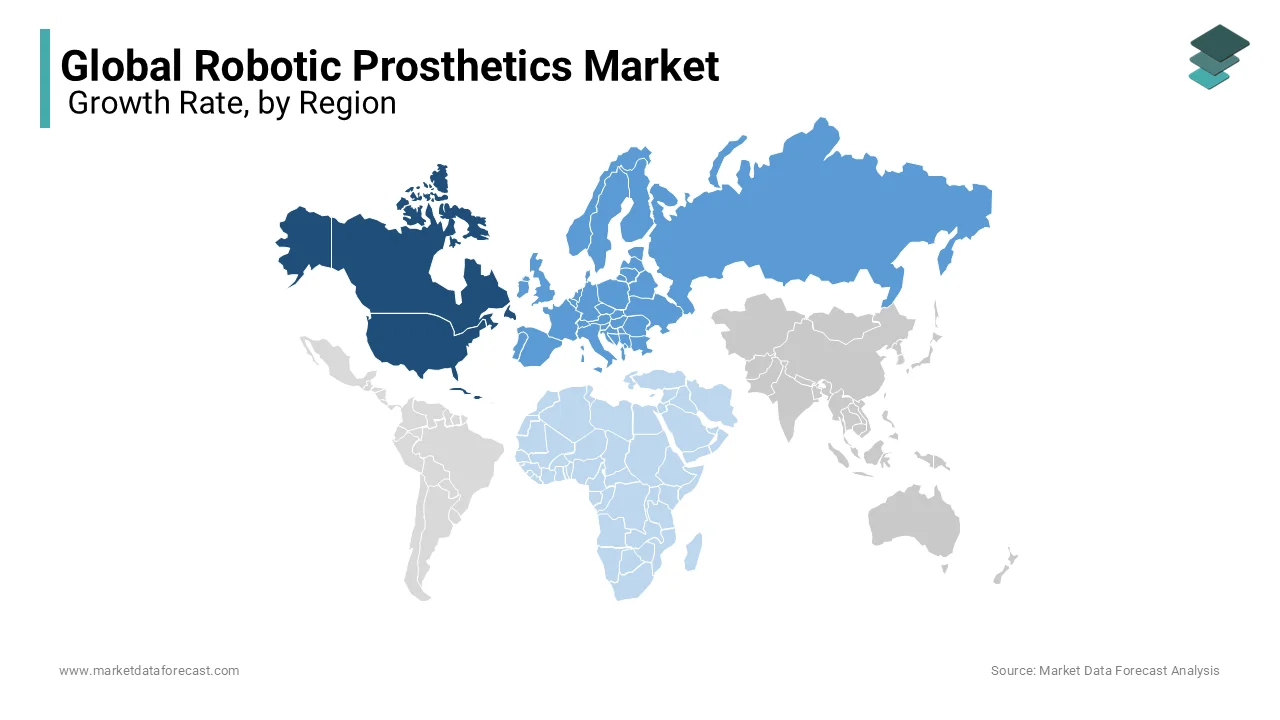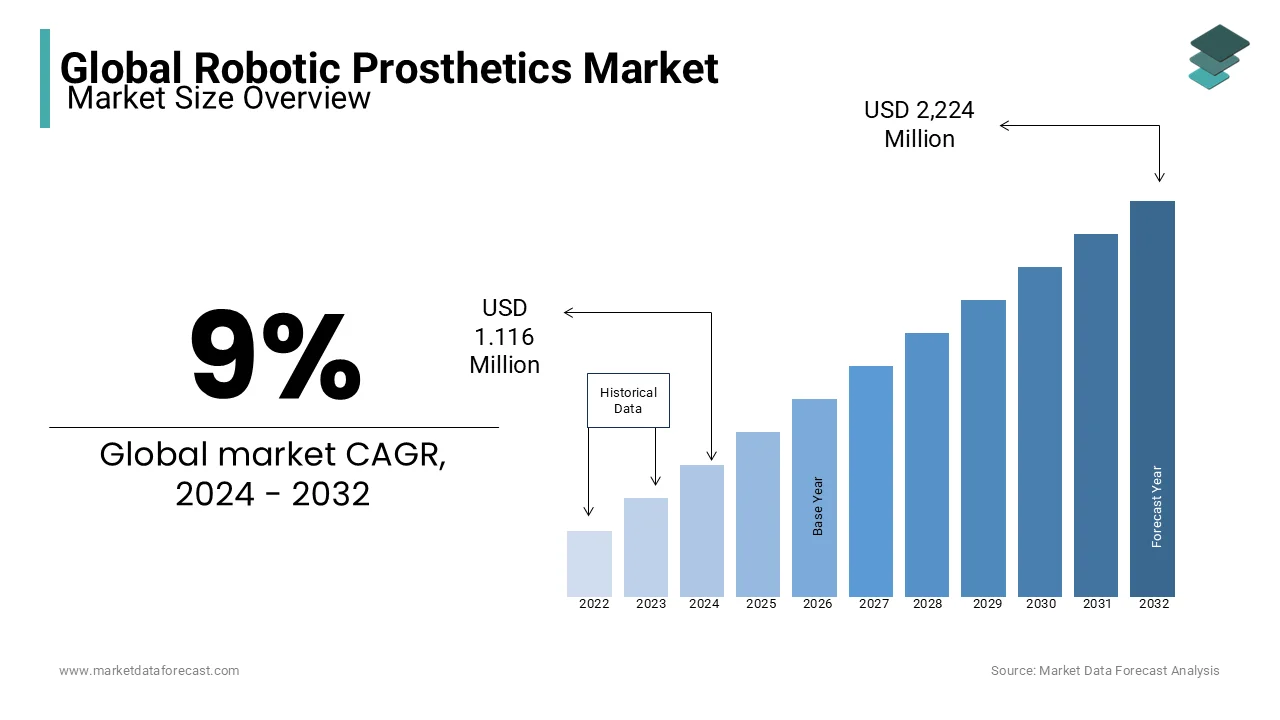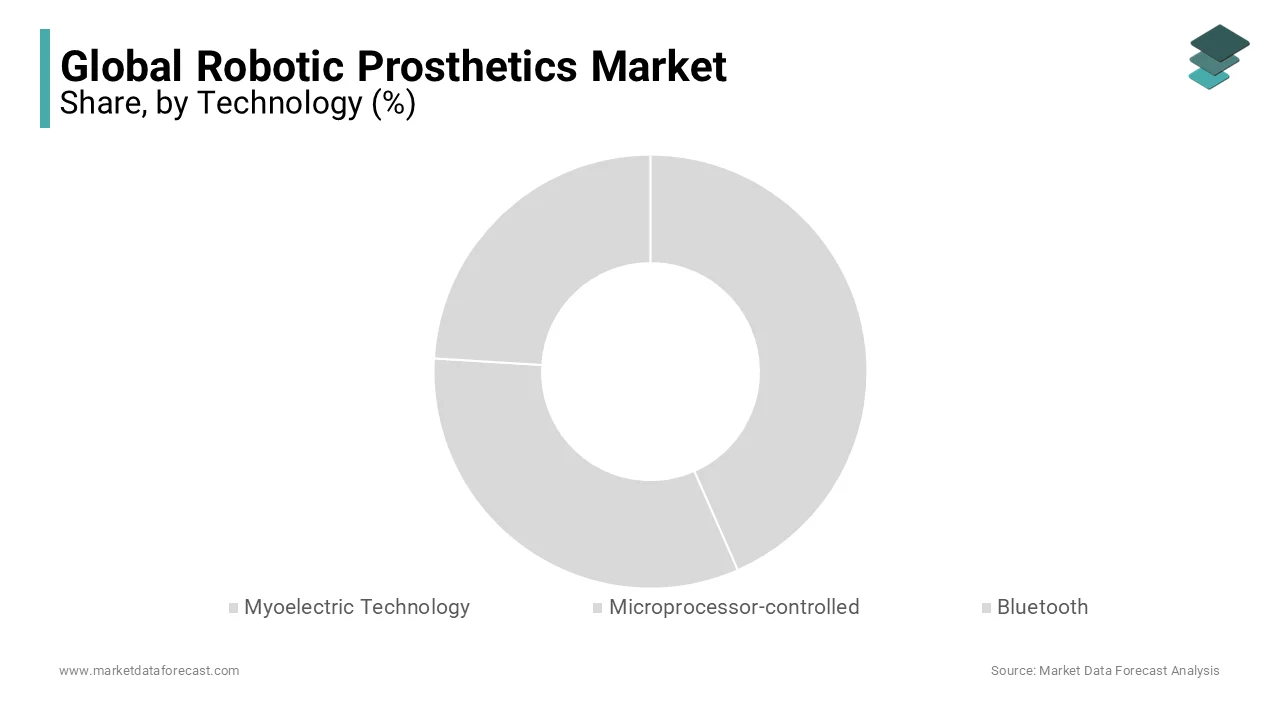Global Robotic Prosthetics Market Size, Share, Trends & Growth Forecast Report By Technology, Products, Application, End User and Region (North America, Europe, Asia-Pacific, Latin America, Middle East and Africa), Industry Analysis From 2025 To 2033.
Global Robotic Prosthetics Market Size
The global robotic prosthetics market was valued at USD 1,116 million in 2024. The global market is projected to grow from USD 1,216 million in 2025 to reach USD 2,424 million by 2033, exhibiting a compound annual growth rate (CAGR) of 9% from 2025-2033.
Robotic Prosthesis control is a method for controlling a prosthesis; the controlled robotic prosthetics restore a biologically accurate gait to a person with a limb loss. These devices enable patients to regain their motor capabilities and even restore sensory feedback; most devices under development are mind-controlled. These advancements will increase robotic prosthetics market growth opportunities in the coming years. In the past few years, robotic prostheses could only perform basic tasks like standing up and walking at constant speed indoors, which accounted for the market's moderate growth. The developments help them perform many complex movements, similar to biological limbs and legs, enhancing the adoption rate globally. Technological advancements like artificial intelligence, biosensors, rising frequency of amputations, gaining population and government financial support, and enlarging research activities all contribute to the market growth. According to Amputee Coalition, 2.1 million people are currently living with limb loss in U.S., majority were due to the chronic diseases like diabetes, peripheral arterial disease and around 45% are due to trauma cases.
MARKET DRIVERS
Rising Amputations Propel Robotic Prosthetics Market Growth
The growing number of amputation cases worldwide is majorly propelling the robotic prosthetics market growth. The amputation cases are rising with time across the world. Factors such as road accidents, diabetes, various cancers, and born handicapped are majorly increasing the population of amputees. As per the International Osteoporosis Foundation stats, 1 in every three women and 1 in 5 men aged over 50 years suffer from fragility fractures in their lifetime. Every year, approximately 536,000 people suffer from fragility fractures in the United Kingdom. More than 6 million people worldwide have undergone upper-limb amputation. Such factors are contributing to the growth of the robotic prosthetics market.
Technological Advancements and Awareness Boost Market Expansion
In addition, increasing research on robotic prosthetic limbs integrated with advanced mechatronics, intelligent sensing, and sensor motor functions for maintaining the physical appearance of amputated limbs drives the market forward. Furthermore, rising awareness regarding robotic prosthetics, a growing number of ulcers, and natural freakishness are other significant factors accelerating the robotic prosthetics market growth. The increasing prevalence of diseases like diabetes, cardiovascular, stroke, and overweight are further favoring the growth rate of the robotic prosthetics market. The growing aging population, the rising number of beheading cases, and technological developments in manufacturing prosthetic devices are enhancing market growth.
MARKET RESTRAINTS
Challenges in Weight, Power, and Cost-Limiting Adoption
The primary issue with robotic prosthetics is weight; most robotic prostheses still need to be lighter to be used daily, limiting their adoption and hampering the global robotic prosthetics market expansion. Another area for improvement is the power; the devices need to be tethered to a power supply, and the limited battery life hinders market share expansion. The high costs associated with robotic prosthetics due to the incorporation of sophisticated technology restrict access to some patients and healthcare organizations due to limited budgets. The need for awareness worldwide and technological difficulties lead to low adoption rates, limiting market growth. Most people and healthcare organizations limit their preference to robotic prosthetics due to limited insurance coverage and ethical and social considerations regarding how it will affect human identity. Some people prefer traditional prosthetics, but all these factors impede market expansion. The stringent regulations regarding the product's safety, quality, and approval are expected to pose a challenge to manufacturers when expanding the market.
REPORT COVERAGE
|
REPORT METRIC |
DETAILS |
|
Market Size Available |
2024 to 2033 |
|
Base Year |
2024 |
|
Forecast Period |
2025 to 2033 |
|
Segments Covered |
By Technology, Product, Application, End Users, and Region |
|
Various Analyses Covered |
Global, Regional & Country Level Analysis, Segment-Level Analysis, Drivers, Restraints, Opportunities, Challenges; PESTLE Analysis; Porter's Five Forces Analysis, Competitive Landscape, Analyst Overview of Investment Opportunities |
|
Regions Covered |
North America, Europe, Asia Pacific, Latin America, the Middle East, and Africa |
|
Market Leader Profiled |
Shadow Robot Company (United Kingdom), Touch Bionics (United Kingdom), Ossur (America) |
SEGMENTAL ANALYSIS
By Technology Insights
Based on technology, the microprocessor-controlled prosthetics segment occupied the leading share of the global robotic prosthetics market in 2024 and the domination of the segment is likely to continue during the forecast period owing to the easy accessibility of prosthetics and increasing R&D activities by the market participants to develop advanced and effective devices.
The myoelectric technology segment is estimated to account for a considerable share of the global robotic prosthetics market during the forecast period. Factors such as rising potency rate, the utilization of electro signals for limb movement, the number of product launches by the key market players, and growing research and development activities are propelling the segmental growth.
On the other hand, the Bluetooth segment is predicted to showcase a notable CAGR during the forecast period owing to the less device or robotic prosthetic cost. Robotic limbs are used to improve the motion of a person in doing some tasks. On the other hand, controlling prosthetics with the mind is an advanced area where most people feel better in their usage. In mind control prosthetics, the signals are received through Bluetooth connected to the patient's nerves in the socket, which drives segment growth.
By Product Insights
Based on the product, the prosthetic feet and ankles segment is predicted to hold the major share of the global robotic prosthetics market during the forecast period. Nowadays, even Prosthetic Arms have come into the limelight. The prosthetic ankles or feet segment holds the largest market share. The growing older people population and the rising number of road accidents are factors responsible for segment growth.
On the other hand, the prosthetic arms segment is estimated to have a substantial share of the global robotic prosthetics market during the forecast period.
By Application Insights
Based on the application, the lower body extremity segment is estimated to witness the major share of the global robotic prosthetics market during the forecast period and is likely to grow at a CAGR of 8.4% over the forecast period. The growth of the segment is majorly driven by the rising accessibility of devices related to lower body extremities, the increasing number of product launches by the key market players, and the growing number of lower body dock cases. These are nothing but, Prosthesis that replaces upper body parts and lower body parts.
The upper body extremity segment is estimated to grow at a healthy CAGR during the forecast period and hold a considerable share of the worldwide market.
By End Users Insights
Based on the end-user, the hospital segment accounted for the largest share of the global robotic prosthetics market in 2024 and is estimated to register the fastest CAGR during the forecast period. The segmental growth is primarily driven by the growing incidence of accidents, the rising number of trauma cases worldwide, the adoption of advanced technologies, and supportable reimbursement policies.
REGIONAL ANALYSIS

Geographically, the North American robotic prosthetics market had the major share of the global market in 2024, and the regional domination is expected to continue during the forecast period. The growth of the North American market is majorly driven by the rapid adoption of technological developments such as robotics, artificial intelligence, and 3D printing in the manufacturing of robotic prosthetic devices, the increasing aging population, rising incidence of amputations, and an increasing number of initiatives by the North American governments in favor of robotic prosthetics. The U.S. captured the major share of the North American market in 2024, followed by Canada, and the same trend is predicted to continue during the forecast period. The growing number of amputation cases is majorly driving the U.S. market growth. In addition, the growing number of people suffering from diabetes in the U.S. region, leading to amputation surgeries needing robotic prosthetics, is further fuelling the growth of the U.S. market. Increasing investments by governmental organizations in the U.S. is another notable attribute fuelling the market growth in the U.S. For instance, the U.S. Defense Department invested significant amounts in the R&D of prosthetics for wounded warriors. On the other hand, the Canadian robotic prosthetics market is predicted to witness a noteworthy CAGR during the forecast period. An estimated 200,000 people per year in Canada suffer from amputees due to diabetes and injuries caused by diabetes in the feet and such people are in great danger of risk resulting in losing their limbs. In Canada, using artificial intelligence, most researchers focus on designing advanced modern robotics prosthetics for people to use daily.
The European market is another promising regional market for robotic prosthetics worldwide. The European robotic prosthetics market is anticipated to hold a substantial share of the worldwide market during the forecast period and witness a healthy CAGR. The growing adoption of technologically well-developed robotic prosthetic products is primarily boosting the regional market. The U.K. market held the major share of the European market in 2024 and is expected to grow at a noteworthy CAGR during the forecast period. The growth of the UK market is majorly driven by the increasing investments by the UK government to further improve the healthcare infrastructure and favorable reimbursement policies. Germany is another notable regional market for robotic prosthetics in Europe and is expected to occupy a considerable share of the European market during the forecast period. The increasing efforts by the international market participants and local manufacturers of robotic prosthetics to capture the potential of Germany are primarily driving the German market growth. For instance, Adapttech partnered with Guenther Bionics on prosthetics distribution in 2024 and Adapttech launched patient mobility in Germany by creating devices for patients to improve their lives. Adaptec designed the INSIGHT System, which is used to improve the fitting process of lower-limb prostheses for amputees. In Germany in 2019, more than 62,000 amputation surgeries were done. Germany has already built an artificial hand with muscles made from bundles of 'smart' wires. Now it is moving forward in manufacturing advanced products for people who are lost limbs and legs due to chronic diseases in Germany.
The APAC robotic prosthetics market is anticipated to be the fastest-growing regional market worldwide during the forecast period owing to the presence of emerging economies, increasing disposable income and rising number of road accidents happening in the APAC countries. India is one of the major markets for robotic prosthetics in Asia-Pacific. The growing number of road accidents and the increasing number of limb loss incidents among the people operating with agricultural machinery are propelling the Indian market growth. Increasing emphasis on manufacturing cost-effective robotic prosthetics by Indian manufacturers is contributing to the Indian market growth. On the other hand, the Japanese market is expected to occupy a considerable share of the APAC market during the forecast period. In Japan, currently, 100,000 people are using prosthetic legs. Japanese research also advanced in making military and non-military applications, strengthening the market growth in this region. Some of the robotic prosthetics need approvals from the government, and the government is also increasing awareness programs for the usage of robotic prosthetics to make disabled person life better.
The Latin American robotic prosthetics market is estimated to grow at a steady CAGR during the forecast period owing to the massive requirement for prosthetics by the people and increasing support from public and private organizations.
The robotic prosthetics market in MEA is predicted to display inclined growth during the forecast period. The regional market growth can be attributed to the increasing adoption of advanced technology in the hospital and the growing prevalence of quality treatment procedures. 3-D printed prosthetic hands are mainly used as robotic prosthetics in South Africa. These researchers focus on manufacturing different robotic prosthetics according to the patient's requirements. They also provide low-cost prostheses in many areas.
MARKET KEY PLAYERS
Some of the most promising companies leading the Global Robotic Prosthetics Market profiled in this report are Shadow Robot Company (United Kingdom), Touch Bionics (United Kingdom), Ossur (America), HDT Global (United States), Endolite (United States), Syn Touch Inc. (United States), Irobot (United States), Northrop Grumman (United States), Qbotix (United States) and Prox Dynamics (United States).
RECENT MARKET DEVELOPMENTS
-
In 2023, Cleveland Clinic Researchers developed a bionic arm. The upper-limb amputations allow users to have the same functions as a person without thinking, behaving, and functioning like a person without an amputation.
-
In 2019, HDT Global (HDT) manufactured a robotic arm and manipulator for QinetiQ to support the U.S. Army's Common Robotic System-Individual program.
- In 2023, MIT and Shanghai Jiao Tong University designed a soft, lightweight, and potentially low-cost neuroprosthetic hand. This Inflatable robotic hand gives amputees real-time tactile control.
MARKET SEGMENTATION
This research report on the global robotic prosthetics market has been segmented and sub-segmented based on the technology, product, application, end-users, and region.
By Technology
- Myoelectric Technology
- Microprocessor-controlled
- Bluetooth
By Product
- Prosthetic Ankles or Feet
- Prosthetic Arms
By Application
- Upper Body Extremity
- Lower Body Extremity
By End Users
- Hospitals
- Clinics
By Region
- North America
- Europe
- The Asia Pacific
- Latin America
- Middle East and Africa
Frequently Asked Questions
What was the value of the robotic prosthetics market worldwide in 2024?
The global robotic prosthetics market size was worth USD 1,116 million in 2024.
Who are the top performing players in the global robotics prosthetics market?
Ottobock, Touch Bionics, Inc., EndoliteSynTouch, Inc., HDT Global, Össur Americas and Shadow Robot Company are playing a leading role in the global robotic prosthetics market.
Which segment by technology is dominating the robotic prosthetics market?
Based on technology, the microprocessor-controlled segment accounted for the leading share of the global robotic prosthetics market in 2024.
How much share was accounted by the North American region in the global robotic prosthetics market in 2024?
In 2024, the North American region occupied a share of 39% in the global robotic prosthetics market.
Related Reports
Access the study in MULTIPLE FORMATS
Purchase options starting from $ 2500
Didn’t find what you’re looking for?
TALK TO OUR ANALYST TEAM
Need something within your budget?
NO WORRIES! WE GOT YOU COVERED!
Call us on: +1 888 702 9696 (U.S Toll Free)
Write to us: [email protected]


